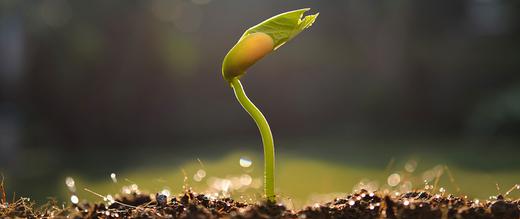The views expressed in our content reflect individual perspectives and do not represent the authoritative views of the Baha'i Faith.
Justice, as a starting point, forms an idea that leads to law.
A nucleus, like any seed, inevitably produces a surrounding, sustaining structure that grows naturally outward from the core concept.
From a Baha’i perspective, we can find the seeds of civilization and all its structures in the sacred writings of the world’s great religions. Embedded in these writings are divine laws, nestling like an embryonic plant within the two halves of a seed. This embryo contains within itself both the essence of the seed, and its source. As the Baha’i teachings tell us:
…the essence of justice and the source thereof are both embodied in the ordinances prescribed by Him Who is the Manifestation of the Self of God amongst men. – Baha’u’llah, Gleanings from the Writings of Baha’u’llah, p.175.
The first growth of the young plant occurs within the newly-inspired religious community. This straight sapling of the laws prescribed by the prophet and founder become known to the members of the community, and they slowly put them into practice. Then this tree eventually grows to shelter all of humanity.
Unfortunately, in the religions of the past, the social and secular laws that grew up around the nucleus of religious law did not always continue to bear a faithful, healthy, dynamic relationship to their original source. To extend the metaphor, the tree does not always grow according to the pattern laid down in its seed. In Australia, a parasitic tree called the strangler fig cannot sprout in soil. Its windblown seeds take root in the higher, sunlit branches of a healthy young tree. From there, the strangler lets down long roots to the soil below. Gradually the roots of this parasite attach themselves to the sapling’s trunk, enveloping the original tree. In the intermediate stages you can still see the straight, slim trunk of the sapling, before it is engulfed by the elaborate, intertwining cords that will become the hollow trunk of the strangler fig. Swallowed at last, the original tree slowly disappears. All that remains is a rigid periphery, unrelated to the core that gave it life.
Religious communities can lose their connection to the living core of their own teachings. Abdu’l-Baha laments:
Alas! A thousand times alas! that this solid foundation is abandoned and forgotten and the leaders of religions have fabricated a set of superstitions and rituals which are at complete variance with the underlying thought. As these man-made ideas differ from each other they cause dissension which breeds strife and ends in war and bloodshed; the blood of innocent people is spilled, their possessions are pillaged and their children become captives and orphans. – Abdu’l-Baha, Divine Philosophy, p. 161.
Rather than relating to the outer dogma and rituals of religion, the truly spiritual must continually try to relate to the ‘underlying thought’ that informs a living religion. That’s the true meaning of religion—relating this flawless, complex nucleus of faith and justice to our own lives and actions, to the concerns and decisions that come to us every day. If we can do this, then we can nourish the vital relationship between the luminous concept of justice and our practical daily efforts to do what is fair and right.
Clearly, if we want justice firmly established as the ruling principle of the world’s social organization, it must be established at every level, until justice becomes the intuitively normal response of each human being to another. This ideal form of justice cannot be achieved through human law. Baha’is believe that we cannot introduce the divine civilization by legislation alone—instead, there must be a change in the human heart to make it possible.
The periphery does not produce its own core, for that would involve growing backwards. The core generates a living and vital periphery. As Justice Lord Devlin has pointed out:
…every worthy society sets for its members standards which are above those of the law. We recognize the existence of such higher standards when we use expressions such as ’moral obligation’ and ’morally bound.’ The distinction was well put in the judgement of African elders in a family dispute: ’We have power to make you divide the crops, for this is our law, and we will see this is done. But we have not power to make you behave like an upright man. – Patrick Devlin, The Enforcement of Morals, pp. 19-20.
The creation of an ideal of justice emerges from the pure relationship between God and humanity. Only faith, that spiritual core which generates a power that flows through the human mind, heart and will, can transform ordinary, selfish, unthinking individuals into upright men and women. In our consideration of the essential concept of justice, we must therefore return to the source of this power, the revelation of God’s laws and principles.
In these sacred writings, the foundational documents of all Faiths, we will find a working definition of justice, and an explanation of how we can put this principle into practice in our daily lives. A working definition of that indefinable concept will naturally grow one step out from the core, made visible in the embryo plant, the first growth from the seed itself.

















Comments
Sign in or create an account
Continue with Facebookor